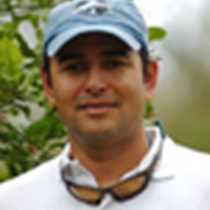Isabela & Fernandina Islands
We traveled all night long to reach the youngest side of the Galápagos Archipelago, the western realms. The oldest islands are found in the east side; most of the volcanic activity in the Galápagos occurs at the western side, precisely by Isabela and Fernandina Islands. This morning we all witnessed the impressive geological features that surrounded us. During our Zodiac ride along the rich shoreline we had multiple sightings: Marine iguanas, Brown noddy terns, Sally Lightfoot crabs, Brown pelicans, Galápagos penguins and Flightless cormorants. All the latter species were admired but the true highlight of the morning was, for many of us, to observe one of the giants of the ocean. We spotted a very large Ocean sunfish (Mola mola). It was not only very impressive but amusing to see how this huge fish propels itself underwater.
In the afternoon, the National Geographic Islander was repositioned to Fernandina Island. We disembarked at Punta Espinoza, from there we headed out for a walk on very young pahoehoe lava flows. Pioneer plant species, such as mangroves and lava cacti survive in the harsh conditions of this volcanic terrain. Our usual daily companions, the Galápagos sea lions, were once again the stars of the afternoon. As hard as it is to believe, each one of them looks cuter than the other! Late in the afternoon we came back home dreaming on the adventures and sightings that our expedition will bring to our lives tomorrow.
We traveled all night long to reach the youngest side of the Galápagos Archipelago, the western realms. The oldest islands are found in the east side; most of the volcanic activity in the Galápagos occurs at the western side, precisely by Isabela and Fernandina Islands. This morning we all witnessed the impressive geological features that surrounded us. During our Zodiac ride along the rich shoreline we had multiple sightings: Marine iguanas, Brown noddy terns, Sally Lightfoot crabs, Brown pelicans, Galápagos penguins and Flightless cormorants. All the latter species were admired but the true highlight of the morning was, for many of us, to observe one of the giants of the ocean. We spotted a very large Ocean sunfish (Mola mola). It was not only very impressive but amusing to see how this huge fish propels itself underwater.
In the afternoon, the National Geographic Islander was repositioned to Fernandina Island. We disembarked at Punta Espinoza, from there we headed out for a walk on very young pahoehoe lava flows. Pioneer plant species, such as mangroves and lava cacti survive in the harsh conditions of this volcanic terrain. Our usual daily companions, the Galápagos sea lions, were once again the stars of the afternoon. As hard as it is to believe, each one of them looks cuter than the other! Late in the afternoon we came back home dreaming on the adventures and sightings that our expedition will bring to our lives tomorrow.



